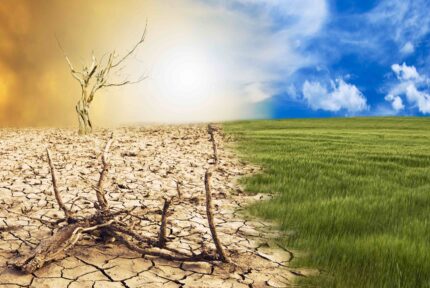Golf Course Soil Salinity is One Piece of an Urgent Global Problem
I want to welcome our fantastic, hard working course superintendent, Stephen Garritson, as our guest blogger (see Stephen’s bio below). Stephen has helped us transform the LCF Country Club golf course into the beautiful course it is today. I invited Stephen to write about any climate related subject pertinent to his work as Course Superintendent. He chose golf course soil salinity, known to non-science types as “way too salty — send it back salty” or “I can’t grow anything here salty.” It turns out that golf course soil salinity is just one piece of an urgent global problem. To Stephen, managing golf course soil salinity levels is all a part of his work at LCFCC. Stephen’s bio is at the end of this post.
Thanks for the intro, Pamela.
One of the first things I had to learn while managing turf grass on courses in Southern California was, get ready…salt level management. Coming from the Midwest in 2011, this was an issue I was unaware even existed. Now, managing salt levels in the soil is one of the most important aspects of my job. I imagine most people reading this have not even heard of this problem. So why should you care that an important aspect of my job is managing salts in two acres of golf course greens?
Salt level management is not a golf course specific problem. It is an environmental problem that affects all soils when exposed to drought conditions. This same problem has already affected one-fifth of the world’s farmlands causing lowered crop yields and damaging economies. Golf course soil salinity is a piece of an urgent global problem. Once farmland is destroyed by salt degradation the solution is usually considered economically unfeasible to repair.
Pamela: Thanks, Stephen. I love that we’re talking about this issue as it relates to our golf course, and probably most golf courses in Southern California — and how that ties into the global problem that many people aren’t aware of.
Stephen, before we jump into your turf grass salinity struggles, let’s take a quick stroll through some little known history of our town, La Cañada Flintridge, to help us understand local water scarcity, and how and why you struggle with salty turf today— and finally, what all that has to do with the climate emergency and how we can help change things.
A Look Back Before Looking Forward — America’s First Environmental Stewards
Before our little foothill area was claimed by the Spanish crown, it was inhabited by indigenous peoples known as the Tongva or, as the Spanish named them, the Gabrielinos. Tongva means, “people of the earth.” The separate villages extended from Palos Verdes to San Bernardino, from Saddleback Mountain to the San Fernando Valley. Each was independent and interconnected. The Tongva lived in harmony with the land and the three rivers which provided them water. Here is also a good place to acknowledge that today, in La Cañada Flintridge, we are on the ancestral land of the Tongva peoples. And here is also a good place to acknowledge that Native Americans were the country’s first and most knowledgeable environmentalists. The treaties signed by the Tongva with the President Fillmore Administration were never honored by the United States government. (A Brief History of LA’s Indigenous Tongva People is a good read).
“With plentiful resources, the Tongva were able to establish a community of more permanence than those usually found in hunter-gatherer societies. They also had a very effective and far-reaching trading network that enhanced their comfort level and provided social stability. All that changed with their encounter with Europeans.” (by Cindy Hardin, LA Audubon Director of Outdoor Education)
The arrival of the Spanish, who brought with them European diseases and invasive species, displaced the native peoples while upending the ecological balance of the region. In the late 18th century, the Tongva who didn’t flee or weren’t killed, were enslaved to help build the San Gabriel Mission. Many died of disease, according to Cindy Hardin. By the end of the 19th century, 250,000 people had been reduced to 9,000. And yet, many Tongva people live in the area to this day, and they work to revive their culture and to have their tribe recognized by the Federal Government — it was recognized by California in 1994. Los Angeles is home to the largest population of Indigenous Peoples in any city in the United States.
Nothing Grows Without Water
Water is certainly life. We human beings are 60% water. Nothing grows without water: not plants, not people, not cities. And it was water that grew La Cañada Flintridge Country Club. But before the town’s growth in the first half of the 20th century, water was always the biggest problem in the La Cañada Valley.
Land developers such as Frank Lanterman — who in 1911 was one of the founders of the Valley Water Company — soon found out that there simply wasn’t enough groundwater in the wells they sunk, nor could enough be piped down from high in Pickens Canyon. Despite the shortage, a real estate boom had begun. In 1950, Lanterman ran for office in the California State Assembly and won. Among other legislative successes, he co-authored the Municipal Water District Act, which led to the 1952 incorporation of Foothill Municipal Water District (and a member of the Metropolitan Water District). Matt Flynn, one of the largest landowners in LCF, established the Mesa Crest Water Company in 1957; today it is known as Liberty Water. Water from the Colorado River and the Western Sierra Nevada began to flow in La Cañada Flintridge, and homes grew up from the ground.
La Cañada Flintridge Golf Course’s Founding Story and Water are Intertwined
Water supply and the new 210 Freeway created yet more growth for the area and that’s when another land developer, Bill Godbey comes into the picture. Godbey was the original developer of both the country club and the surrounding “Enchanted Hills Estates,” later called the La Cañada Flintridge Country Club Estates — 413 acres in all. He was allowed to develop the land; yet there was a condition attached, we are told. That condition, part of the club’s founding story, will be revealed in our Part Two of this dry, salty, worrisome, look at drought, turfgrass and climate. Golf course soil salinity wasn’t a worry in those days of 1962; although the region is no stranger to periodic droughts. The LCF Country Club swung open its mid-century doors in October 1962. It changed hands when Gilbert Dreyfuss and a small group of investors purchased the club in 1976. It’s had its ups and downs, but the club is supported by the families in the area who enjoy the beautiful setting and family friendly recreation at affordable rates. Next year, 2021, is our 60th year anniversary.
Stephen: Everybody can understand that drought can lead to a lack of water supply, but that is just one piece of the puzzle. Salt degradation is another consequence of drought conditions that most people have never even heard of. I was talking to an important person in my life about what seems to be the beginning of a very sustaining drought. Their answer to my concern was, “It’s ok. They will just find a way to pump in more water.” The problem with this statement is it does not fix increasing salt degradation globally.
Pamela: Right. Salt degradation leads eventually to desertification, the process by which fertile land becomes desert, typically as a result of drought, deforestation, or inappropriate agriculture. According to UNESCO, one third of the world’s land is threatened by desertification. Not exactly uplifting, but a good way to propel activism and change is by knowing what’s at stake. *Make sure to read part 2, so that you may sleep peacefully knowing the full story!
 Stephen has been at LCF Country Club since September of 2016. Pre our club, he provided tournament playing conditions for several PGA Tour and NCAA events and came to us from Seacliff Country Club in Huntington Beach. Before that, he spent two years, from 2011-2013, as Senior Agronomist at Riviera Country Club in Pacific Palisades. He has a Bachelor of Science degree in Turfgrass Science from Purdue University in Indiana, which covered everything from organic chemistry to plant physiology, turf grass culture, and plant science.
Stephen has been at LCF Country Club since September of 2016. Pre our club, he provided tournament playing conditions for several PGA Tour and NCAA events and came to us from Seacliff Country Club in Huntington Beach. Before that, he spent two years, from 2011-2013, as Senior Agronomist at Riviera Country Club in Pacific Palisades. He has a Bachelor of Science degree in Turfgrass Science from Purdue University in Indiana, which covered everything from organic chemistry to plant physiology, turf grass culture, and plant science.*
Sources:
The Tongva struggle for recognition timeline
Soil Salinization as a Major Global Challenge
Digital Storytelling Map of Tongva People
A Brief History of LA’s Indigenous Tongva People




I enjoyed reading this. Thanks
Thanks for reading and stay tuned for part two!
Thank you to you and Steve that was very informative. The club is very lucky to have Steve because of his knowledge and hard work. Also Pamela you are entitled to Cudos for your PR work.
Thank you so much, Mr. Wenker. We agree about Stephen. He’s an asset to us and an all around “hail fellow well met.”
Wonderful and informative article. It also brought back memories. I was a college freshman when the club first opened my mom worked at JPL. She was invited to events there or as a guest of a member. It was “the” place to be. Always elegant and I couldn’t wait to go. Now Don and I have been members nearly 36 years. Our girls grew up there and they and now grandkids learned to swim and/or play golf there. A wonderful, safe family environment.
Thank you so much for sharing your memories of the club. So many wonderful family experiences and friendships are a part of our now 60 year history.
Can’t wait for part 2. It was nice reading all the history and I am interested in reading about the solutions in treating the soil. My family and I also have enjoyed the club for many years. I am always in on ways to save our planet and help with climate change.
Hi Cristina,
Thanks so much for your comment on the first half of the blog post. And we’re always so gratified to hear that members and their kids have enjoyed the club for many years. We love to make a welcoming atmosphere for families to enjoy time together in a beautiful setting. On the blog post, the 2nd part is posted. Here’s the link: https://lcfcountryclub.com/part-2-golf-course-soil-salinity-is-one-piece-of-an-urgent-global-problem/
Take care and thanks again for taking the time to let us know how we’re doing:)
i live under a golf course runoff,,, the creek now has evolved to hard as concrete ,,due to minerals precipitating out of solution,,,, help!